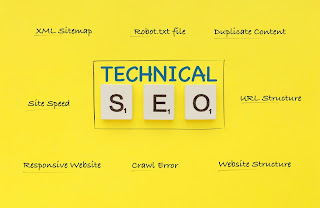Technical SEO Strategies to Enhance Your Website Visibility
In today's digital landscape, where the majority of online experiences begin with a search engine query, having a strong online presence is essential for businesses and individuals alike. This is where Search Engine Optimization (SEO) comes into play. While content and keywords are crucial components of SEO, technical SEO forms the foundation upon which your website's visibility, accessibility, and user experience are built.
Understanding Technical SEO
Technical SEO refers to the optimization of your website's
infrastructure and backend elements to improve its search engine ranking and
user experience. It involves various strategies and techniques that focus on
the technical aspects of your website, ensuring that search engines can crawl,
index, and understand your content effectively.
Key Technical SEO Techniques and Strategies
1. Website Speed Optimization
A fundamental aspect of technical SEO is optimizing your
website's loading speed. Rapidly loading websites not only cater to users'
impatience but also influence search engine rankings. Slow-loading sites can
result in higher bounce rates and lower search engine positions. To enhance
website speed, consider employing various strategies. Compressing images and
other media, minimizing the use of unnecessary code, and utilizing browser
caching are effective ways to reduce page load times. Additionally, leveraging
Content Delivery Networks (CDNs) can distribute content across various servers,
ensuring faster access for users in different geographical locations. By
focusing on website speed, you improve user experience and provide search
engines with a positive signal that can contribute to higher rankings.
2. Mobile-Friendly Design
The mobile-first era has shifted the focus of SEO towards
mobile devices. Google and other search engines prioritize mobile-friendly
websites, considering the prevalence of mobile browsing. A mobile-friendly
design ensures that your website is accessible and visually appealing on
various screen sizes and devices. Responsive design, where your website adapts
its layout based on the user's screen, is a recommended approach. Such designs
eliminate the need for separate desktop and mobile versions of your site,
streamlining maintenance and ensuring a consistent user experience.
Mobile-friendliness not only improves user satisfaction but also positively
impacts your search engine ranking, making it a crucial element of technical
SEO.
3. Crawlability and Indexing
For your website to appear in search results, search engine
bots must be able to crawl and index its pages. Creating a clear and organized
sitemap.xml file helps search engines navigate your site's structure and
discover all of its pages efficiently. This XML file acts as a guide, informing
search engine crawlers about the hierarchy and relationships between different
pages. Additionally, the "robots.txt" file allows you to control
which areas of your site should be crawled and indexed and which should be excluded.
Proper utilization of these files ensures that search engines understand your
content and can index it accurately, contributing to improved visibility in
search results.
4. HTTPS Implementation
Website security is paramount, not only for user trust but
also for search engine ranking. Google, among other search engines, favors
secure websites in its rankings. Implementing Hypertext Transfer Protocol
Secure (HTTPS) involves encrypting data exchanged between a user's browser and
your website's server. This encryption protects sensitive information from
potential cyber threats. By adding an SSL (Secure Sockets Layer) certificate to
your website, you signal to users and search engines that your site is secure
and trustworthy. This can lead to improved user experience and higher search
engine visibility, as secure websites are prioritized in search results.
Embracing HTTPS demonstrates your commitment to user security and can
positively influence your website's overall performance in the digital landscape.
5. Structured Data Markup
Structured data markup, commonly implemented using
schema.org vocabulary, adds context to your content, helping search engines
understand its meaning. This markup enhances your website's appearance in
search results by generating rich snippets—additional information displayed
beneath the link, such as star ratings, event details, or recipe cooking times.
Rich snippets provide users with more information upfront, making your listings
more enticing and informative. This can lead to higher click-through rates and
improved visibility. By incorporating structured data markup, you enable search
engines to better comprehend the nuances of your content, ultimately enhancing
the relevance and appeal of your listings in search results.
6. Canonicalization
Duplicate content can harm your SEO efforts by confusing
search engines about which version of a page to index. Canonicalization
addresses this issue by specifying the preferred version of a page. Canonical
tags are added to the HTML of the page and indicate the original source of
content when similar content exists on different URLs. Search engines then
prioritize the canonical version for indexing, consolidating ranking signals
and preventing duplicate content issues. By implementing canonical tags, you
ensure that search engines attribute the correct value and authority to the
right content, streamlining your website's performance in search results.
7. XML Sitemaps
An XML sitemap serves as a navigation guide for search
engine crawlers, helping them discover and index your website's pages more
effectively. This file lists important URLs, along with metadata about each
page, providing a comprehensive overview of your website's structure. Regularly
updating your XML sitemap ensures that search engines are aware of new content,
changes, or deletions. This proactive approach enhances the accuracy of your
website's indexation and increases the likelihood of your content appearing in
relevant search results. XML sitemaps facilitate communication between your
website and search engines, ensuring that your pages receive the visibility
they deserve.
8. Internal Linking
Internal linking involves connecting different pages within
your website using hyperlinks. These links guide users from one page to another,
facilitating navigation and information discovery. From an SEO perspective,
internal linking distributes link authority throughout your site, which can
influence the ranking of linked pages. By strategically placing links to
relevant content, you guide users and search engine crawlers to valuable pages.
This practice not only enhances user experience but also improves the
visibility of important content, as search engines perceive linked pages as
more valuable and authoritative.
9. Site Architecture and Navigation
A well-designed site architecture and navigation system
contribute to an intuitive user experience and improved search engine
understanding. An organized structure makes it easier for users to find
relevant content, reducing bounce rates and increasing engagement. Search
engines, too, benefit from a clear hierarchy as they decipher the relationships
between different pages and sections of your site. An intuitive navigation
structure enhances your website's crawlability, ensuring that search engine
bots can effectively discover and index your content. By designing your site
architecture with both users and search engines in mind, you create a seamless
browsing experience that supports your SEO objectives.
Technical SEO Techniques and Strategies - Conclusion
Technical SEO is the backbone of your website's search
engine visibility and user experience. Implementing the right techniques and
strategies can significantly improve your site's performance in search results,
drive organic traffic, and enhance user satisfaction. As search engine algorithms
continue to evolve, staying up-to-date with the latest technical SEO trends and
best practices is crucial for maintaining a competitive online presence. By
investing in technical SEO, you're investing in the long-term success of your
website on the digital stage.
Useful Links:
https://neilpatel.com/blog/technical-seo-site-audit/
https://moz.com/beginners-guide-to-seo/technical-seo
https://www.pixelsolvent.com/what-is-technical-seo-various-aspects-you-should-know/
https://yoast.com/what-is-technical-seo/







Comments
Post a Comment